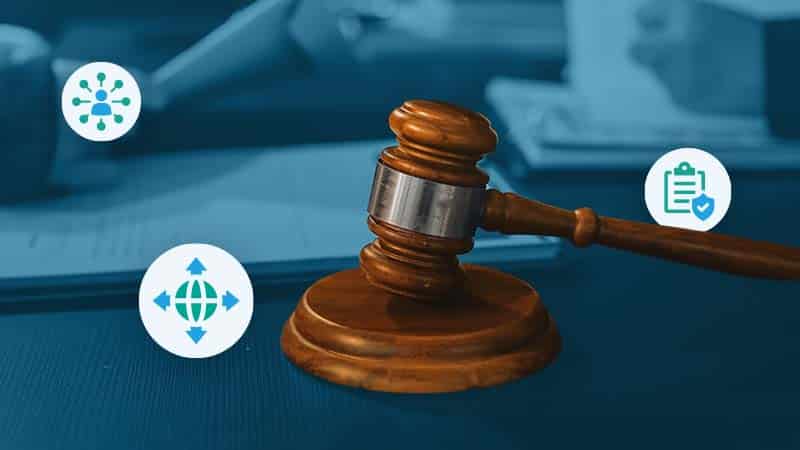Table of Contents
- Integrate Data Sources and Align with Governance
- Data Governance Informs Master Data Model and Improves Stewardship
- Integrated Relationship Management with Microsoft Purview and Profisee
- Match, Merge and Enrich Azure Data with Golden Record Management
- Maximize the Effectiveness of Your Azure Data Governance Efforts
- Complete Your Azure Data Estate Today with Purview + Profisee MDM
In this four-part blog series, we explore the critical, complementary disciplines of data governance and master data management (MDM). While these principles hold true for any deployment, here we focus on the Azure cloud.
This is Part 3 in the series. Be sure to read Part 1 on whether you can trust your data in Azure, Part 2 on the risks poor data quality poses to your cloud investment and Part 4 on why Microsoft Purview and Profisee MDM are the clear choice for governance and MDM in Azure.
Regardless of whether you are undergoing a digital transformation, developing a business intelligence (BI) or analytics program, increasing operational efficiency or meeting compliance requirements, you may be considering a data governance program to supplement your cloud investments and increase the value of your enterprise data.
Even if you have already begun the work of identifying data sources, measuring your data gap and designing a governance framework, you still need to enforce your data rules and standards — and measure whether your efforts are effective.
Data governance and master data management (MDM) are two complementary disciplines and technologies with the same goal of unlocking the power of your data as a strategic asset on the route to informed business decisions, agile solutions and robust analytics.
It’s important to recognize though that as important as they are, neither MDM nor data governance form a complete solution by themselves. But together, they form a solid foundation for complete, consistent and trusted data that will be an asset to the business.
Read on to learn how you can use MDM to integrate and connect your data sources; match, merge and enrich data from your source systems; share metadata and other relationships to your data catalog; measure the effectiveness of your data governance program; and automate workflows and notify data stewards of their responsibilities.
Integrate Data Sources and Align with Governance
The first step in using MDM to effectively manage your data in Azure is to integrate the data from all your source systems.
MDM can handle data from multiple source systems both operating in Azure and from external sources, including ERPs, CRMs, custom applications, cloud applications, legacy apps and more.
As you integrate various customer, product, location and other types of master data, you will likely encounter several issues across source systems such as missing, incomplete, duplicate or conflicting information.
For example, records of customer purchases and their marketing interactions may reside in your CRM while billing and payment terms are stored in a different system.
This may not be a problem when analyzing data by source system because each system only contains fields for the data it needs. But as you begin to compile master data from multiple systems, you need to determine how to best consolidate, clean, merge and reconcile data across the enterprise.
If you already have an established governance framework, you already have a great foundation for resolving these data quality issues. With the release of Microsoft Purview, organizations utilizing the Azure technology stack have a native option for unified data governance of on-premises, multi-cloud and SaaS data.
The Purview Data Map helps organizations establish a foundation for effective data governance by creating a unified data map of all enterprise data across all sources. Users can classify data using built-in and custom classifiers and Microsoft Information Protection sensitivity labels.
When organizations can visually assess the locations of sensitive data by label or classification, and drill down to the details of each data asset, they can better inform their master data model and start their master data management implementation on a solid footing.
Data Governance Informs Master Data Model and Improves Stewardship
Large enterprises with correspondingly complex and expansive data estates can present challenges.
Even experienced data stewards responsible for managing and remediating issues as they arise may not know all the nuances of data definitions and requirements. Also, all data stewards are unlikely to interpret them in the same way, so real-time online access to the defined data standards can only help enforce enterprise-wide data consistency.
The ideal technology framework is to have two distinct, complementary governance and MDM platforms with native, bi-directional integrations for the master data model and data stewardship.
For example, the Profisee platform’s native integration with Purview allows institutional knowledge captured as data definitions within Purview to be made available for use within Profisee, thus bringing knowledge of corporate data closer to when users need it most — when managing critical and time-sensitive information.
Profisee’s Governance Data Service integrates with both Microsoft Purview and Azure Active Directory. It provides lookup services to portal users, which allows them to retrieve enriched governance data about the entities and the attributes that they are working on in the Profisee environment.
Some MDM vendors claim to provide full governance functionality as part of their suite of products. Conversely, some governance applications claim to merge records and synchronize data across source systems.
But either of these options alone likely lacks crucial functionality and coverage that would be native to dedicated governance and MDM solutions.
Because any MDM initiative requires organizations to do at least a small amount of data governance to determine which data quality rules to implement and enforce, having a well-integrated data governance program can shorten the time for cataloging data sources, reviewing their structure and lineage and designing the required master data definition.
Integrated Relationship Management with Microsoft Purview and Profisee
One of the challenges when planning for master data management is determining what constitutes master data and which data sources will populate the master data model. This is another significant benefit of using two complementary, integrated solutions like Purview and Profisee.
Purview creates a rich source of enterprise metadata that informs the master data model and enriches the catalog of data that data managers can use to better align with line-of-business (LOB) systems.
This enables users to easily reconcile conflicting terminology, yielding a master data model that optimally reflects the terminology and definitions that business users need while avoiding outdated and misleading terms, key functions of data governance.
This work of comprehensively scanning data sources and determining lineage, metadata and other rules in Purview saves time and ultimately adds more value to the MDM investment as the data models are aligned from the outset.
Because Purview can display the metadata from the full array of data sources, the team tasked with creating the master data model has all the relevant information at their fingertips — making it more likely they make a robust model during their first effort.
Profisee’s Governance Data Service integrates with both Microsoft Purview and Azure Active Directory. It provides lookup services to Profisee users, which allows them to retrieve enriched governance data about the entities and the attributes that they are working on from within the application.
In addition to glossary and definitional information, data stewards can also see contact information for the listed owners and experts for a particular piece of information, should they need additional guidance. When resolving data issues, they can contact the LOB expert and determine what to do.
Match, Merge and Enrich Azure Data with Golden Record Management
Now that you have developed your master data model and have it integrated with your data governance program, you need a mechanism for maintaining the quality of your data and develop a workflow for remediating any future data quality issues.
Profisee’s industry-leading matching engine gives companies the ability to identify and group sets of duplicate records using machine learning-based fuzzy matching logic to create a distinct set of data.
Profisee’s survivorship features automatically create and populate golden records with the best information available across source systems, according to detailed survivorship rules. For example, a CRM may have the most complete record of a customer’s name, address and purchase history while the billing system has crucial purchase and billing information and a more detailed company name.
While each system may have the minimum amount of information it needs to effectively serve the business user, there are often cases of incomplete data (i.e., customer mailing address in the CRM and customer shipping address in the ERP) or discrepancies (i.e., company name listed as ‘IBM’ in the CRM and ‘International Business Machines’ in the ERP) across source systems.
Master data management (MDM) provides the key step of matching, merging and combining data from multiple source systems into a trusted golden record.
The golden records, then, are the most accurate, complete and comprehensive representation of any master data domain and can be safely used as key data for any application across the enterprise.
Golden record management is a key component of MDM in that it provides data stewards a single, ideal environment to resolve data quality issues and produce a single “source of truth” of this critical master data.
And multidomain MDM gives an even greater advantage in that data stewards can use the same UI and build business rules using the same platform regardless of the data domain. For example, fuzzy matching rules that have been tuned over time can be applied to product, customer, location data and more — without requiring data stewards to build new rules or learn a new platform.
In addition to managing several data domains with the same UI and platform, multidomain MDM solutions let organizations share reference data across domains. Reference data is a subset of master data that is used for classification across the organization. Postal codes, transaction codes, cost centers and customer/sales regions are all types of master data.
This is another critical advantage of multidomain MDM, as reference data is rarely domain-specific and efforts to manage and maintain reference data have historically been duplicative across single-domain applications.
For example, when filling out a CRM profile for a customer based in Puerto Rico, a LOB user may have entered the abbreviation “PR” into the “state” field even though Puerto Rico is technically a U.S. territory and not a state.
This may be sufficient for customer communications but may cause issues when the finance team cannot properly bill a customer because they do not have Puerto Rico in their list of states.
This is a simple example, but it illustrates the importance of centrally building and maintaining these reference data rules in the MDM hub — and documenting it as part of your governance efforts — so that you only have to build these rules once for business users to have access to a single, comprehensive, set of reference data.
Maximize the Effectiveness of Your Azure Data Governance Efforts
Another big advantage of using MDM in concert with a dedicated governance program in Azure is that it helps organizations measure the effectiveness of their governance efforts.
The Profisee Workflow makes it quick and easy to orchestrate and automate your most complex data quality rules established in Purview. You can capture cross-functional business processes as a sequence of actions that can be performed sequentially or in parallel, orchestrating complex and composite data management activities.
Ensure business processes are executed in the right order, on time — and monitor them to ensure service-level agreements are met. For example, matching, address verification, business rules, task generation, notifications and more complex business processes can easily be automated with workflows.
Data stewards can be assigned tasks and responsibilities, and automated notifications ensure data quality issues are resolved. This helps organizations achieve the full benefits of their data governance initiative: measurable proof that their data quality rules are being enforced and that their data is always trusted and up to date.
Complete Your Azure Data Estate Today with Purview + Profisee MDM
As companies transition their data estate to Microsoft Azure, they need improved visibility and governance of their data assets.
Microsoft Purview helps organizations catalog, classify and govern the broad data estate while Profisee MDM can match and merge master data into a trusted golden record to enforce data-quality standards across data sources.
To see the Profisee platform and its deep integration with Microsoft Purview and the rest of the Azure stack, schedule a demo today.
For the full story and technical details, download The Complete Guide Data Governance and Master Data Management in Azure.

Forrest Brown
Forrest Brown is the Content Marketing Manager at Profisee and has been writing about B2B tech for eight years, spanning software categories like project management, enterprise resource planning (ERP) and now master data management (MDM). When he's not at work, Forrest enjoys playing music, writing and exploring the Atlanta food scene.











